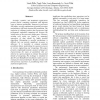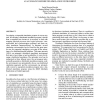1003 search results - page 46 / 201 » How to Parallelize Sequential Processes |
WCRE
2002
IEEE
14 years 1 months ago
2002
IEEE
Scientific, symbolic, and multimedia applications present diverse computing workloads with different types of inherent parallelism. Tomorrow’s processors will employ varying com...
WSC
2004
13 years 10 months ago
2004
Developing a sequential simulation program is not an easy task. Developing a distributed simulation program is harder than a sequential one because it is necessary to deal with ma...
ISCA
1992
IEEE
14 years 24 days ago
1992
IEEE
A quantitative analysis of program execution is essential to the computer architecture design process. With the current trend in architecture of enhancing the performance of unipr...
AAAI
1997
13 years 10 months ago
1997
Negotiation has been extensively discussed in gametheoretic, economic, and management science literatures for decades. Recent growing interest in electronic commerce has given inc...
BMCBI
2008
13 years 8 months ago
2008
Background: When term ambiguity and variability are very high, dictionary-based Named Entity Recognition (NER) is not an ideal solution even though large-scale terminological reso...



